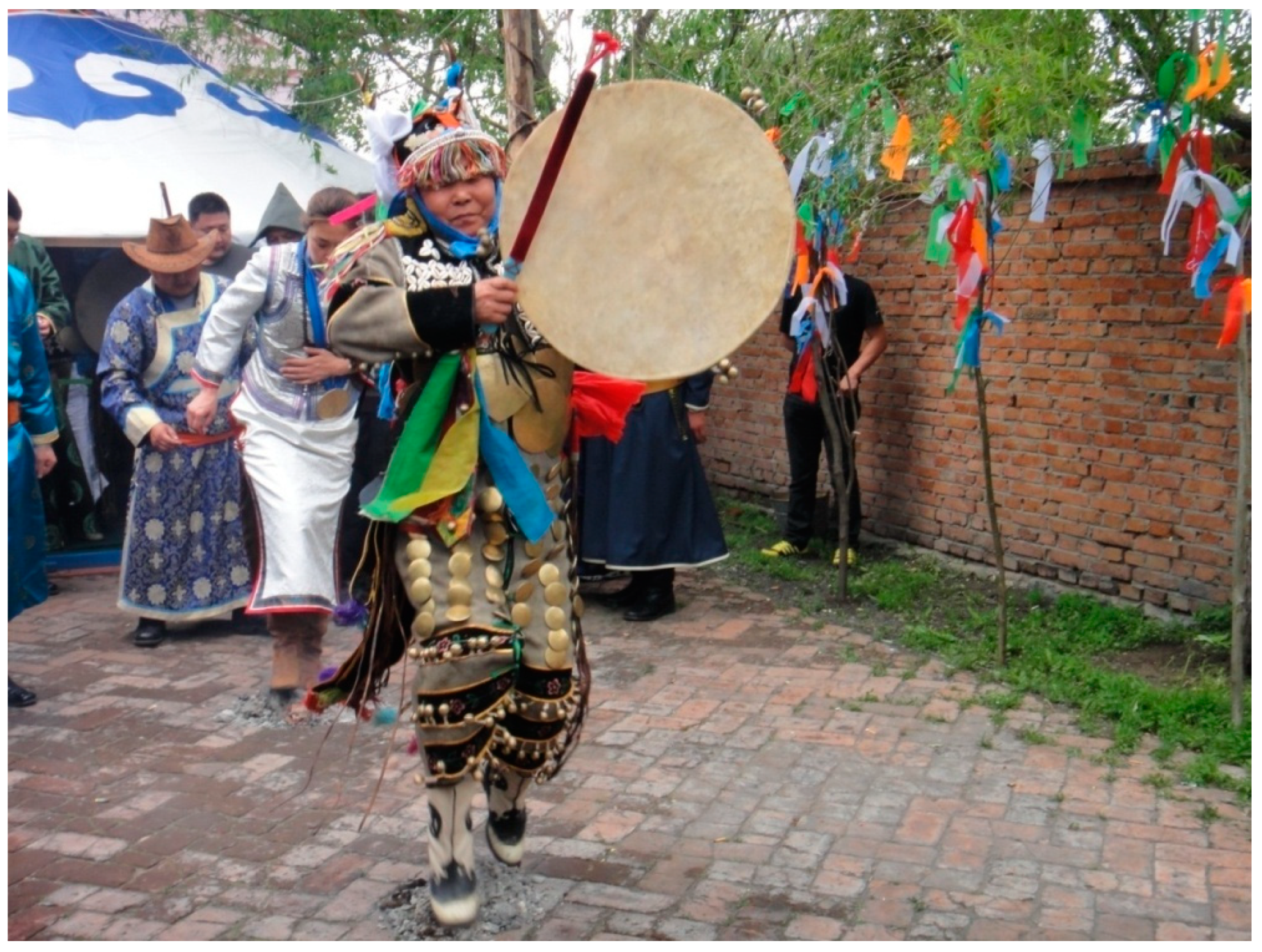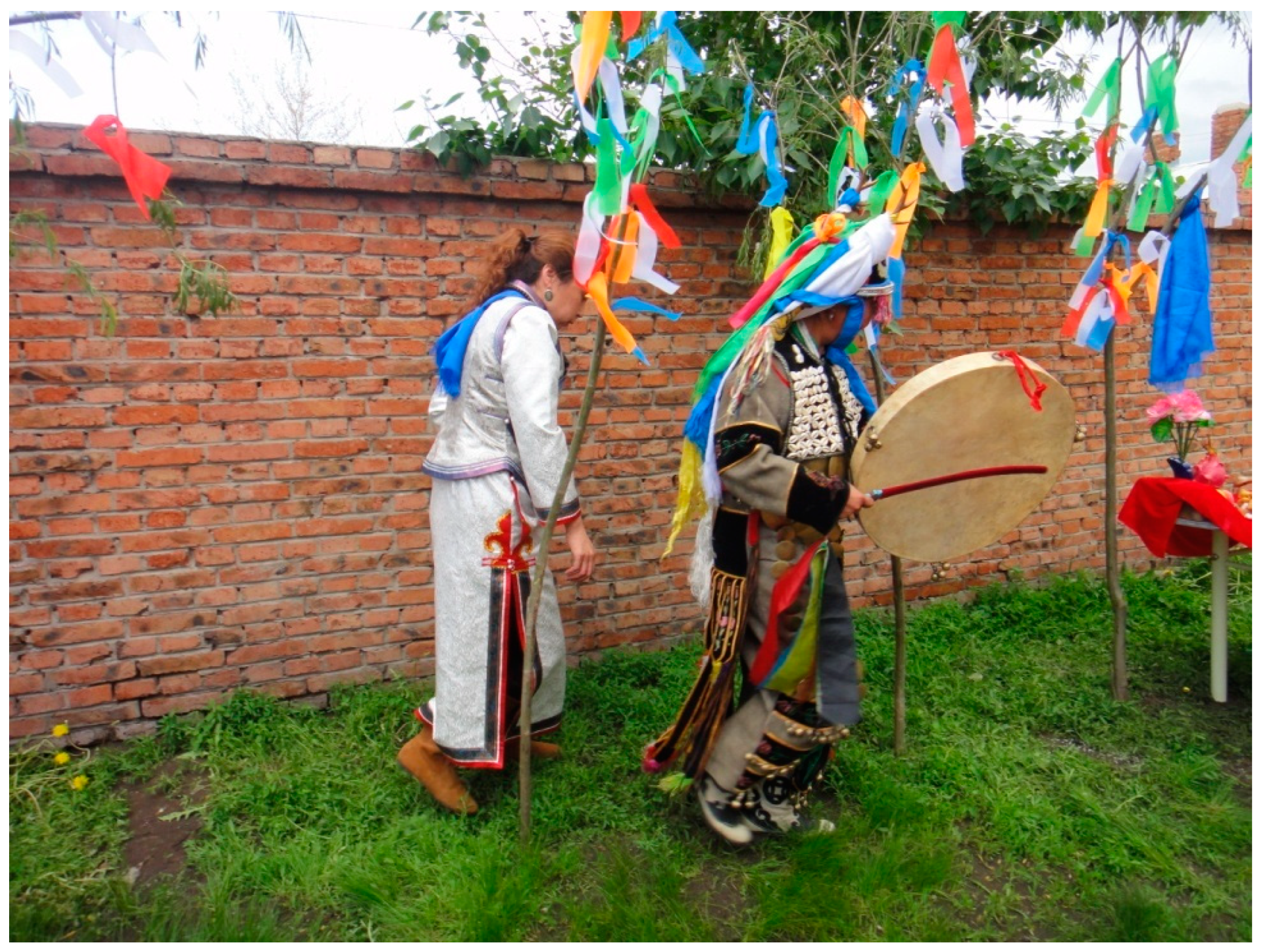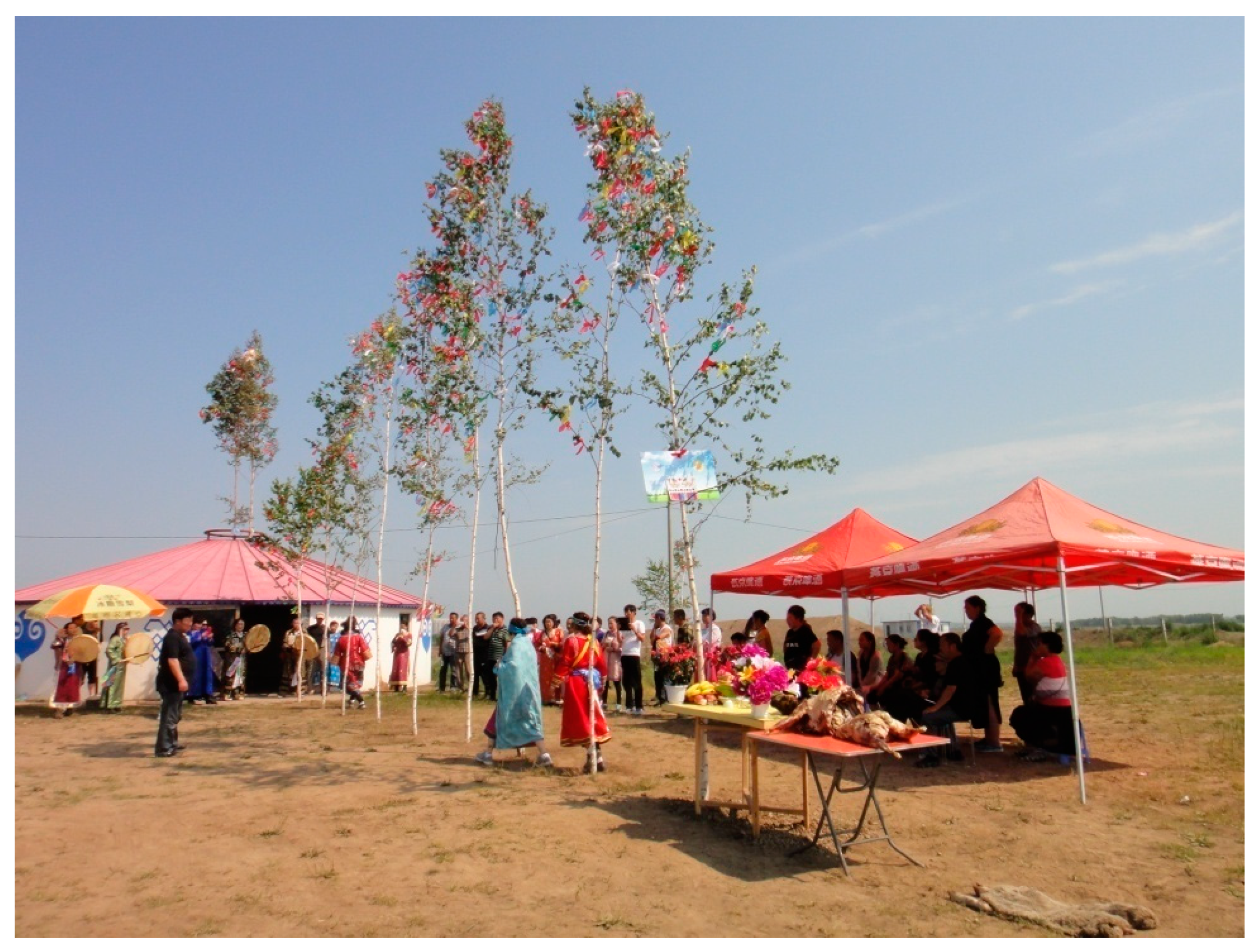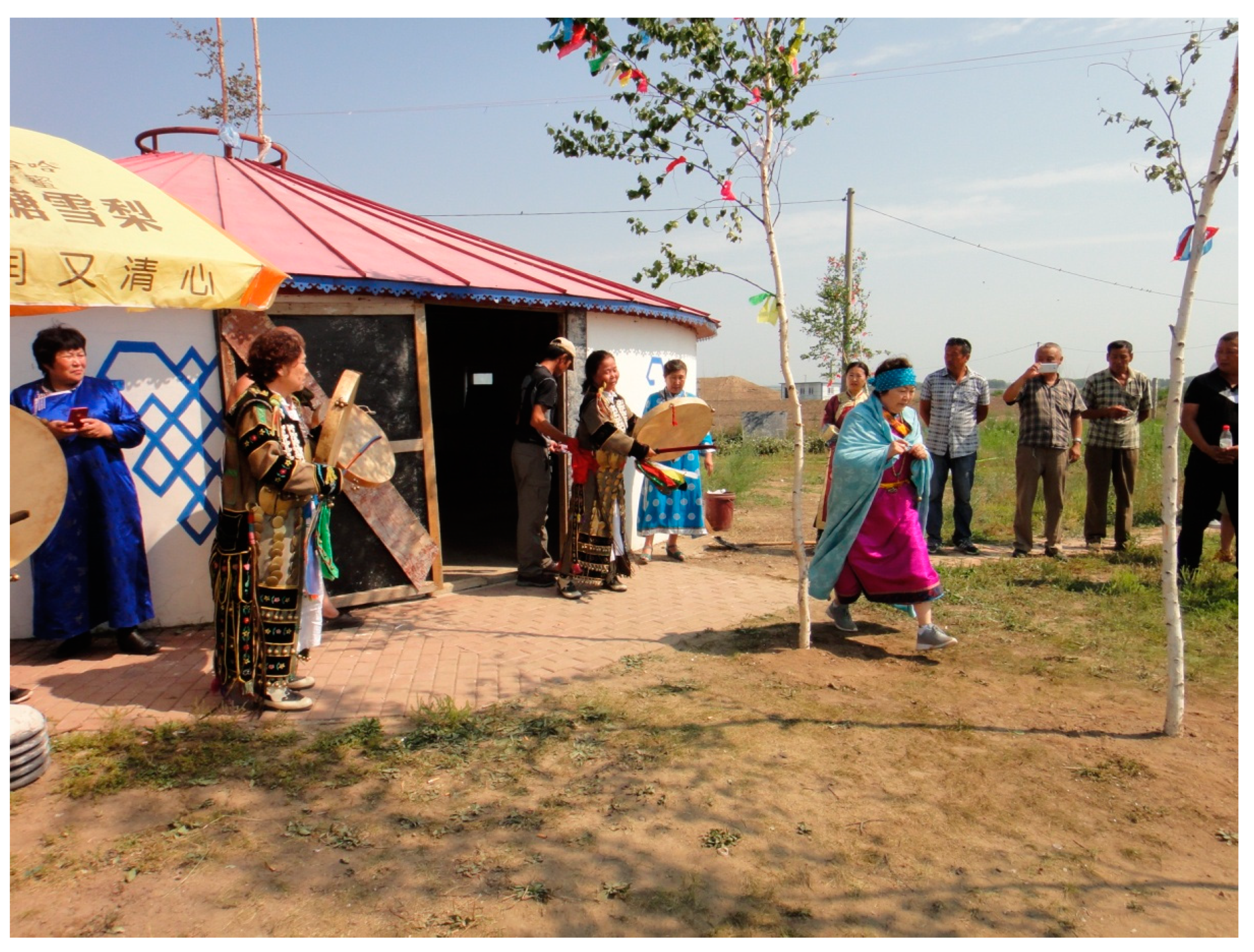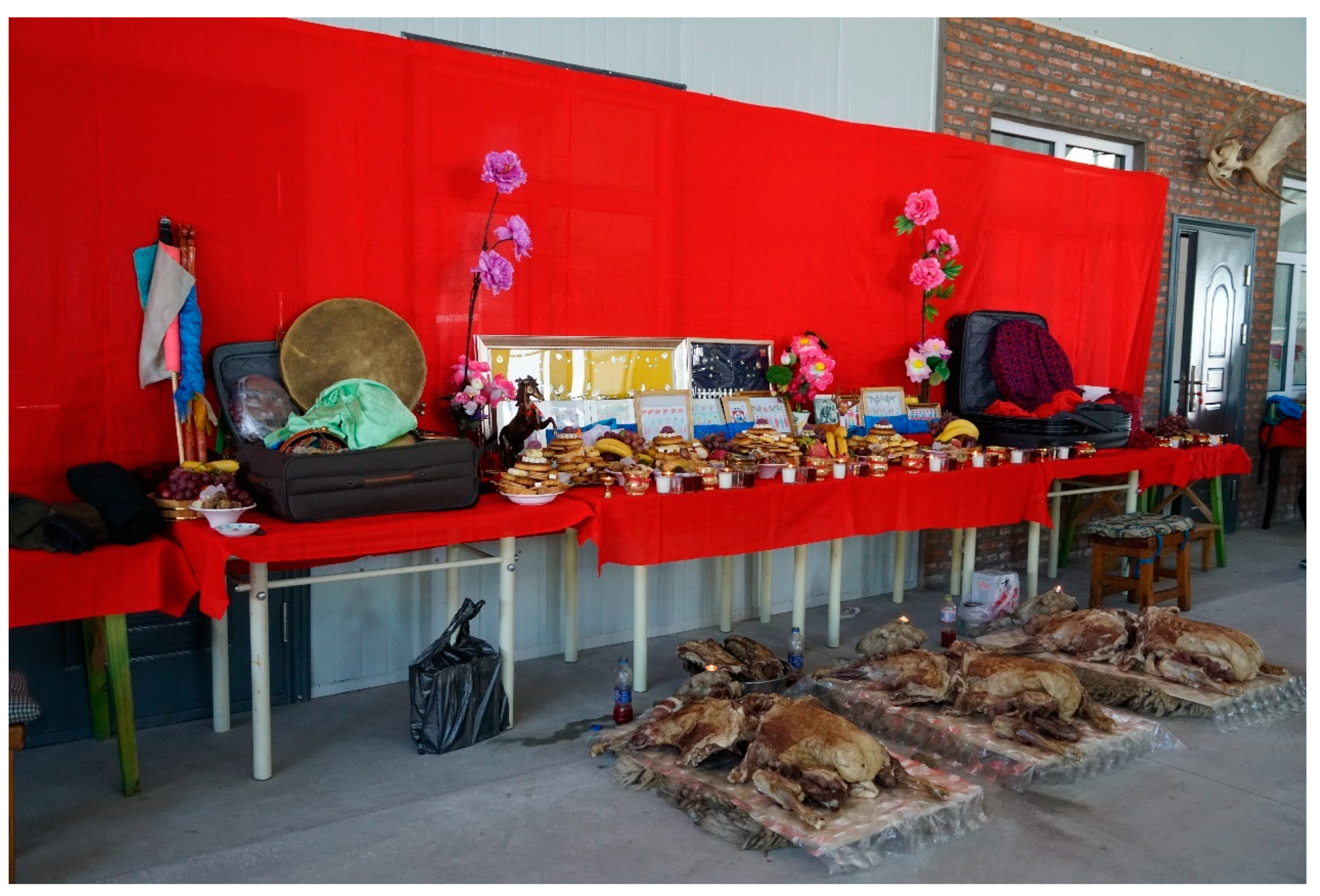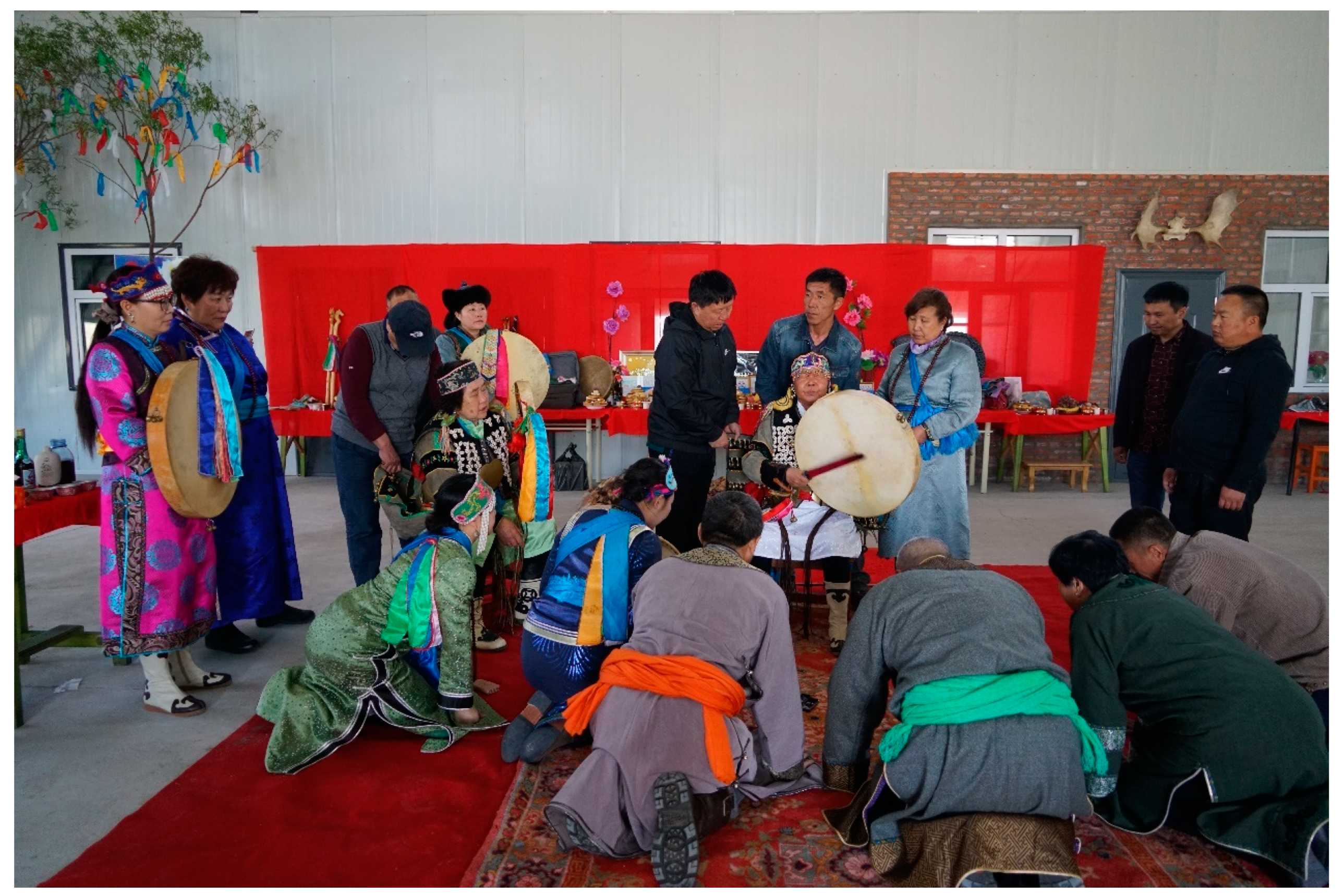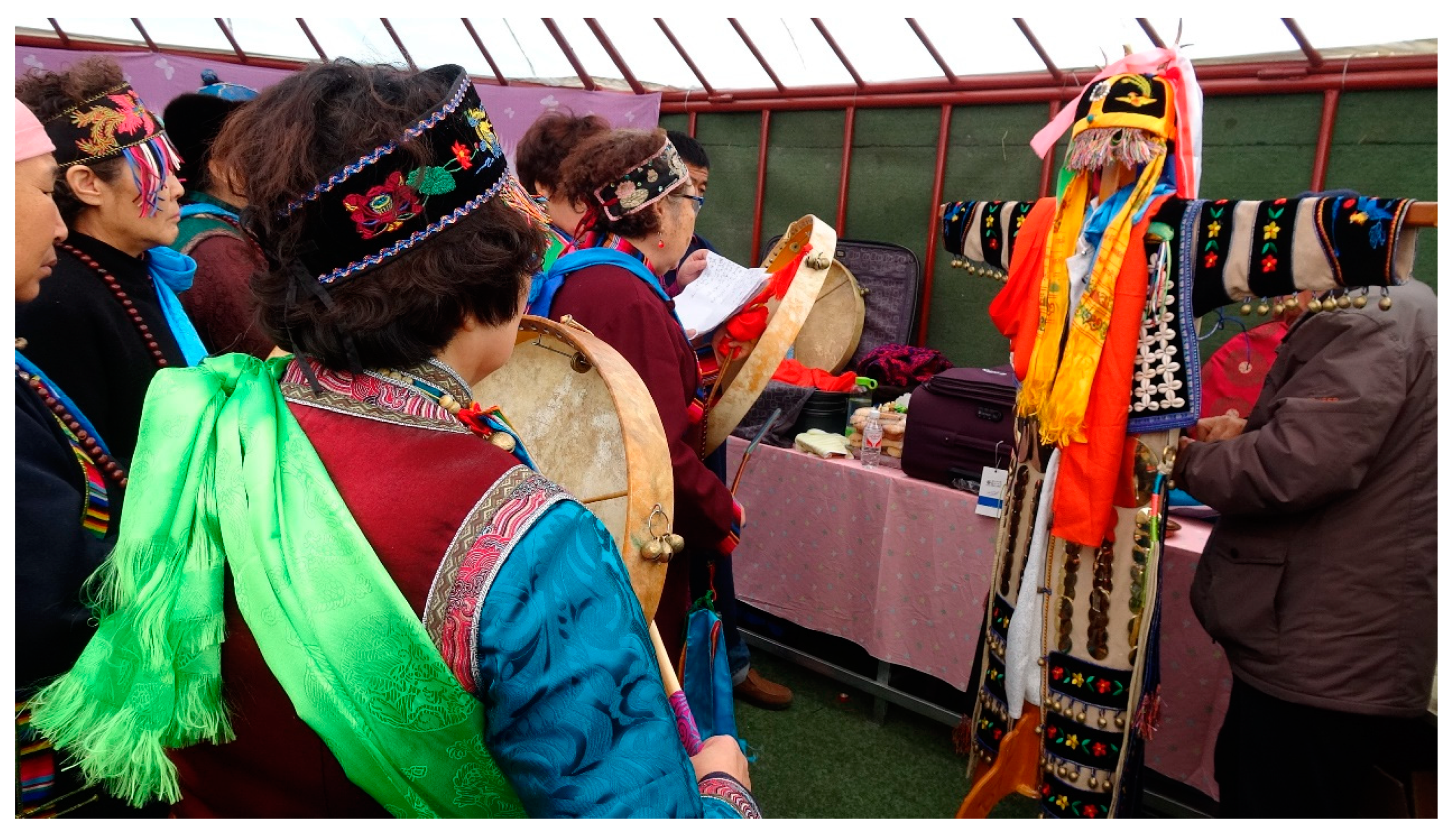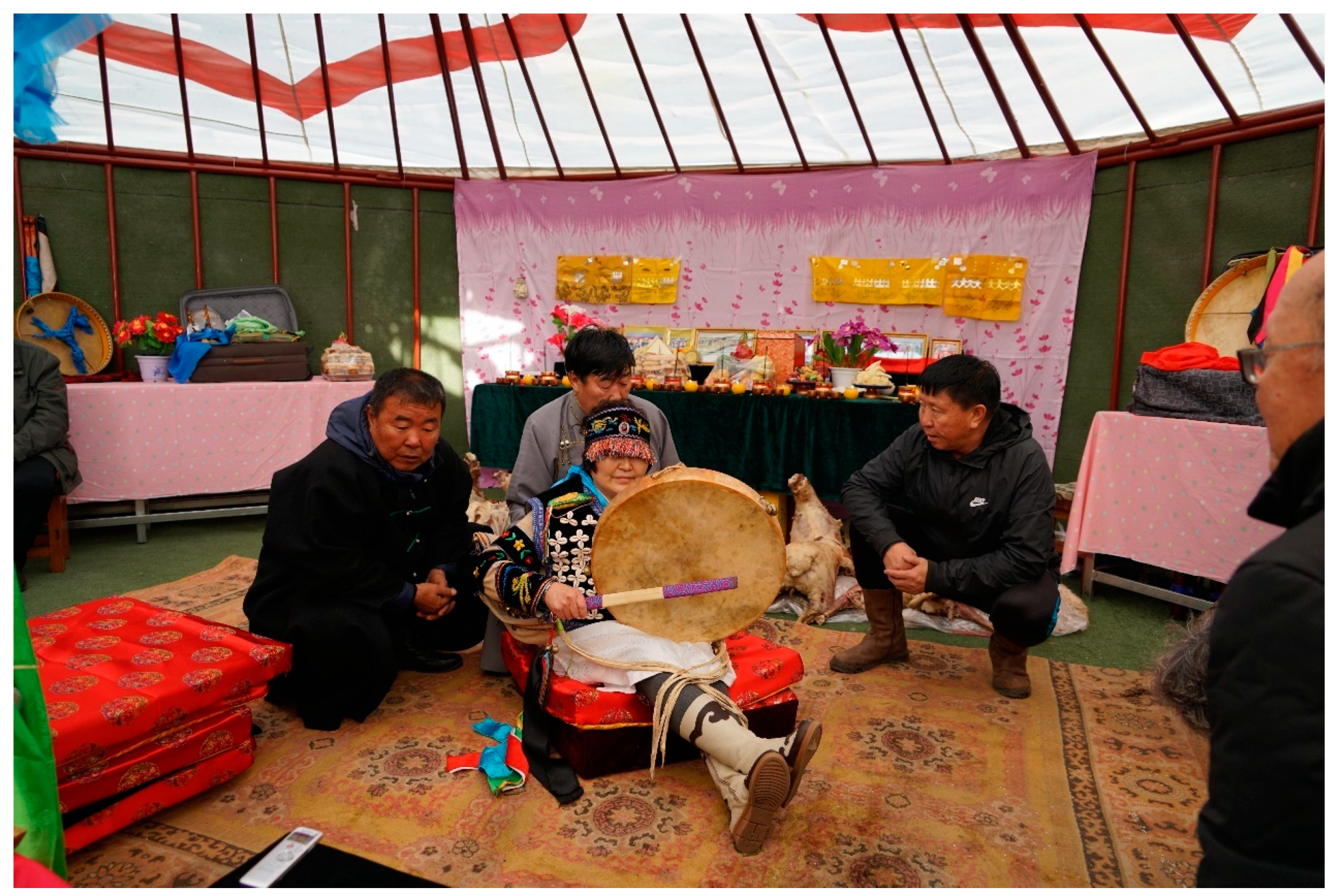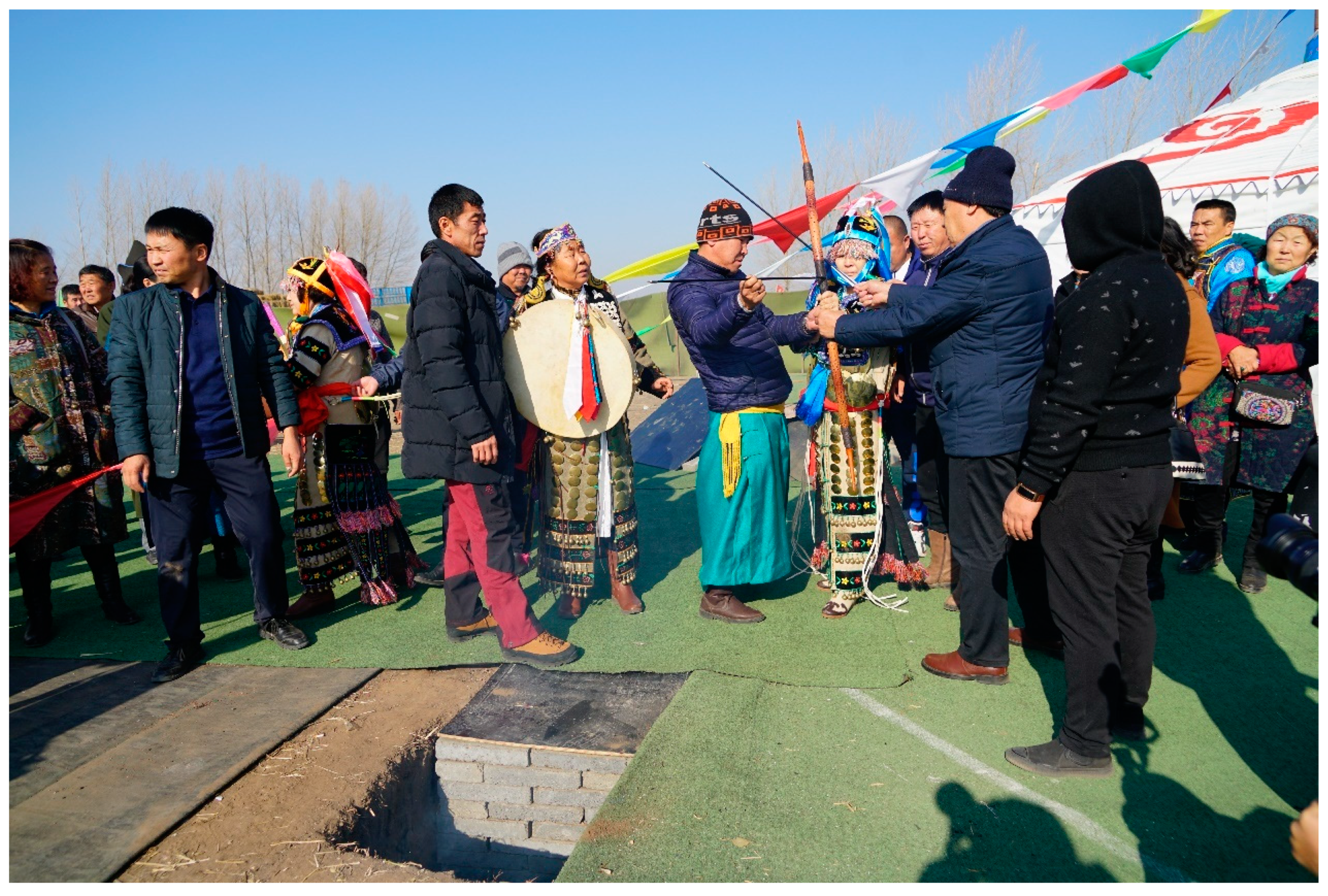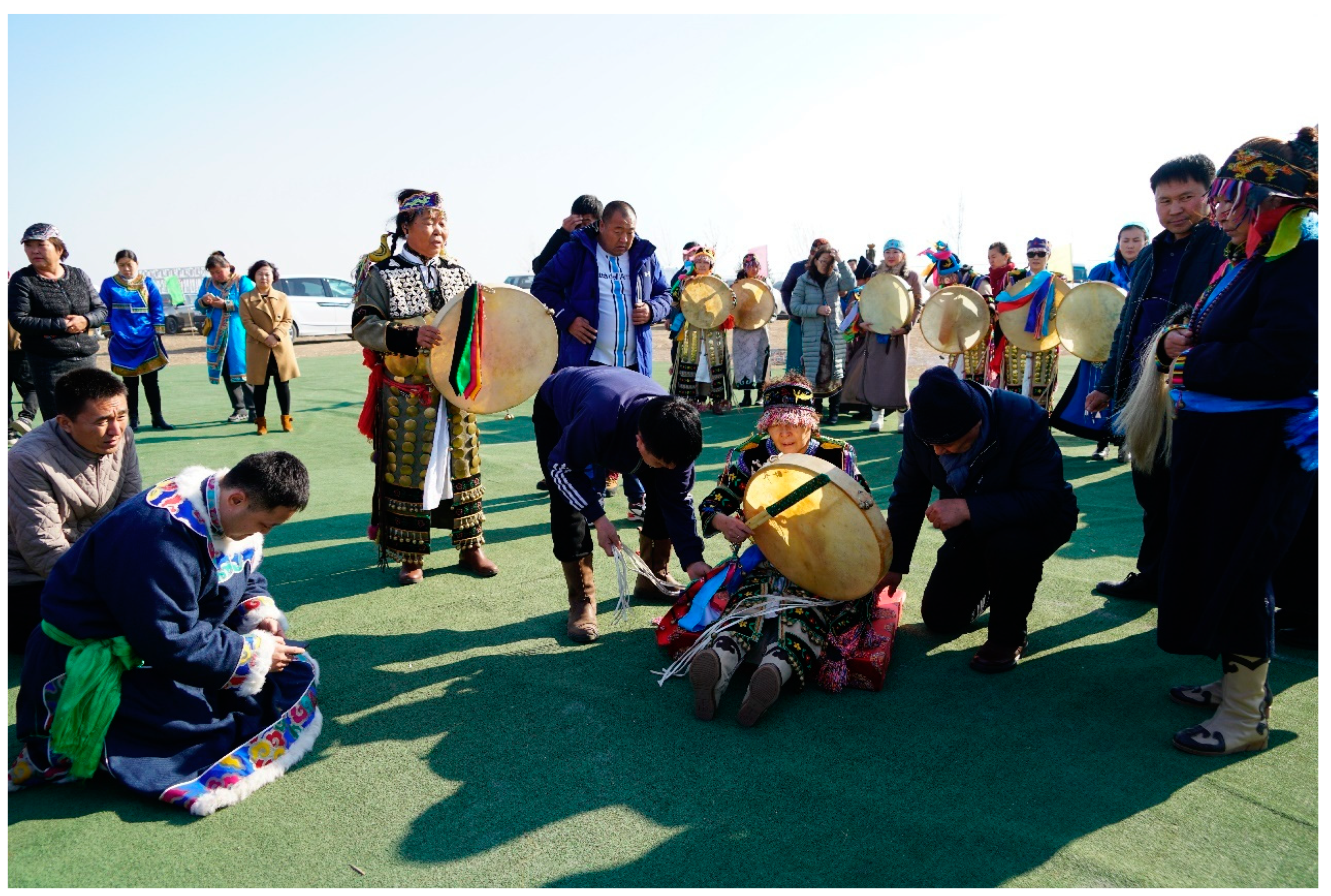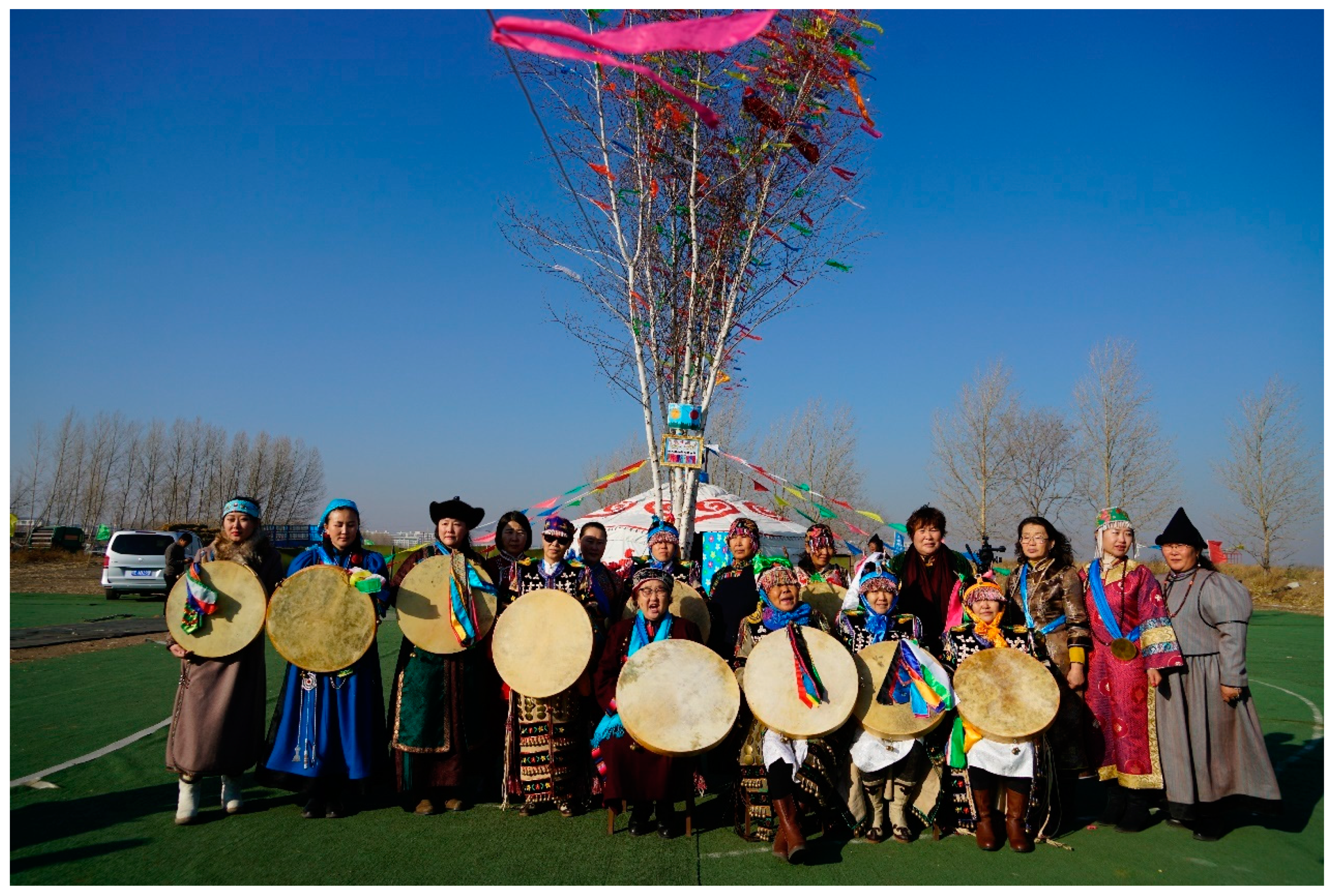1. Preface
The Daur people are an ethnic group living in Northeast China. The Dauric language is an Altai-Mongolic language with no written standard. In 2010, the total population of the Daur was approximately 130,000. There are different views regarding the origin of the Daur people among Chinese and overseas scholars as well as in non-academic circles. Many scholars in Europe and the United States have attributed the Daur to one of the Ewenki (Tungus) families. Japanese scholars generally believe that the Daur is one of the branches of the Mongolians (
Ōmachi 1995, p. 46). At present, some Chinese scholars believe that they are descendants of the Khitan (
Kara and Hoppal 2009, p. 14).
After migrating from north of the Heilongjiang River to the Nenjiang River in the early Qing Dynasty, the Daur were regularly conscripted to serve in the banner system of the Qing emperors and were responsible for three duties, namely participating in war, patrolling the border, and garrisoning Karuns (the Manchu word meaning guard posts). They were successively dispatched and settled in frontier counties such as Aigun, Hulun Buir (Hölön-Buir), Mergen, Buteha, Qiqihar, Hulan, and other places in Xinjiang such as Yili and Tacheng. As a result, nowadays the Daur as a whole inhabit vast areas, yet live in individual compact communities (
Manduertu 2007, pp. 181, 192). At present, most of the Daur people live in the Hulun Buir area of Inner Mongolia, Qiqihar of Heilongjiang Province, and Tacheng of Xinjiang. The Daur people of Hulun Buir are geographically divided into two groups: some live in the plains along the banks of the Nawen River (Nenjiang) and the Nomin River on the east side of the Greater Khingan Range, whereas another group lives in the Yimin and Hailar River Basin in the territory of Hailar and the Ewenki Autonomous Banner. The Daurs living in the former area where the Morin-Dawaa Daur Autonomous Banner is situated are known as
Bat’ən Daur.
The basic unit of Daur society is the equal clan,
xal-mokun. A clan is called
xal in Daur (Manchu
hala) and its branches are referred to as
mokun (Manchu and Daur). The
xal was the basic organ of the Daur patriarchal clan society. Group membership is based on blood ties, members share a common patriarchal ancestor, common living areas, common economic life, and social and cultural activities. Each
xal names itself by the name of the mountain or river in its ancestral area. This social structure continued into the early 20th century. As population increased, the
xal split into a number of more closely related branches—
mokun, which functioned as
xal and became the basic unit of Daur society. Since the early years of the Republic of China, the surname of members in the same
xal or
mokun has been reduced to a single Chinese character by the homonym or free translation of its Daur
xal-mokun name (
Ōmachi 1995, p. 47).
The Daur religion is based on shamanism. The
Bat’ən Daur, living in the Morin-Dawaa Daur Autonomous Banner, have maintained the most original and strongest religious tradition since they have been living in a relatively isolated area. Those Daurs in Qiqihar, who have had frequent contact with the Han people, have been influenced by Taoism. Daurs in Hailar, though deeply influenced by Tibetan Buddhism, still maintain forms of shamanism (
Ōmachi 1995, p. 47). After the 1940s, the inheritance of the Daur shaman was interrupted for about 50 years, and it did not recover until the beginning of the 1990s. After the founding of the People’s Republic of China in 1949, folk religions and beliefs were regarded as “feudalistic superstition”, and thus, most shaman rituals were performed secretly. Although there were a few publicly active shamans at that time, religious people, especially the elderly, tended to worship the spirits in private and invited the shamans to cure diseases in secret. In 1978, the Chinese government began to implement a policy of Reform and Opening-up, the economy started to flourish, and many local cultures also revived. In the late 1990s, the shamanistic tradition began to recover and ceremonies started to be held in public. In 2005, the State Council of China promulgated the “Notice on Strengthening the Protection of Cultural Heritage”; shaman songs, dances, costumes, and rituals have been included in a list of protected Intangible Cultural Heritage. Some revered Daur shamans such as Siqingua and her disciples in the Hulun Buir area of Inner Mongolia have emerged during the past two decades. They practise a large number of sacrificial ceremonies and rituals, and are the most active, typical, and representative shamans in the Hulun Buir region as well as in Northeast China.
The contemporary Daur shamans, represented by Shaman Siqingua and her disciple Wo Jufen, with their re-interpretation of traditional rituals reflect the inheritance and innovation of shamanism in the new era, which is of great value and significance. Their efforts in revitalizing shamanism do not only consist in imitating the traditions, but also to re-explain shamanism with modern languages and viewpoints, often leading to interesting innovations. The inheritance system functions against this background of tradition and new freedoms. In the course of inheriting and developing shamanism, their activities have been very influential and have gained widespread attention in society, even attracting the attention of domestic and foreign academics.
I am ethnically Ewenki. My father is Solon Ewenki and my mother is Daur. I was born in Morin-Dawaa Daur Autonomous Banner and speak both the Chinese and the Dauric languages, which is a distinct advantage in field research. Thanks to my ethnic background, I am very familiar with local Daur culture and customs. Moreover, I have been observing and interviewing the shamans and their rituals for a long time and have received their trust and support. I have even been allowed to participate in some private ceremonies such as offering sacrifices to the ancestors conducted at the end of every year.
Over the past 10 years, I have been studying the rituals of Daur shamanism, the lyric texts of the shamanic invocation songs, polytheism, animism and their beliefs. I participated in more than 40 rituals of Siqingua and her disciples, including offering sacrifices to ancestors, initiation rituals, ɔbɔː rituals, lʊs rituals, and ɔminaːn (ominaan) rituals; I also interviewed Shaman Siqingua and Wo Jufen, and some elderly people acquainted with shaman traditions on themes such as the Daur’s belief in polytheism and worship activities, and shaman, the medium between the spirit world and people. I have conducted many interviews and compiled nearly 300,000 words of interview notes; more than 200,000 words of shamanic invocation songs have been translated. This article, taking the invoking ritual of Siqingua and her disciples as an example, aims to explore the inheritance and changes of the contemporary Daur shaman.
Some of the field research pictures of the rituals of Shaman Siqingua and her disciples are shown in
Appendix A.
3. The Inheritance Principle of the Daur Shaman
3.1. Mokun Shaman (xʊʤʊr jad’ən) is Strictly Inherited Along the Paternal Lineage
The most fundamental principle of the Daur inheritance is to inherit according to the patrilineal lineage. As mentioned above, the Daur’s
jad’ən consists of
xʊʤʊr jad’ən and general
jad’ən. A
xʊʤʊr jad’ən is the one having
xal-mokun’s
xʊʤʊr barkən (the ancestral spirit) as his god, the title of which is not hereditary, but a
xʊʤʊr jad’ən must be a member of the
mokun, and no other
mokun member can be this
mokun’s
xʊʤʊr jad’ən. That is to say, the
xʊʤʊr jad’ən who takes his
xal-mokun’s xʊʤʊr barkən as the major god must be inherited within the
mokun family, and must be from the members of the
mokun, either male or female (
Neimenggu Zizhiqu Bianjizu 1985, p. 258). This is the most fundamental principle of the inheritance of
xʊʤʊr jad’ən.
The shamanic ability of xʊʤʊr jad’ən passes on along the patrilineal line, and thus, the ancestral spirits will pick the successor among the descendants of the paternal family. Usually, there is no problem with male inheritance within the family. A grandfather may pass it on to his son, grandson, or great-grandson, while it sometimes may be passed to the daughter or granddaughter. Once a married woman is selected by the ancestral spirit, she will take the ancestral spirit of the father’s xal-mokun, and return to her parents’ home to hold the initiation ritual. The ability of the aunt may be passed on to a nephew, a niece, a grandniece, or a grandnephew. After her death, the ancestral spirit will return to her original mokun family to find the next generation of shaman. So none of her descendants would be chosen since they are the descendants of her husband’s xal-mokun.
3.2. Ordinary Shaman (bəːdi jad’ən) Can Be Inherited According to the Maternal Lineage
The ordinary
jad’ən is called
bəːdi jad’ən because they take outside spirits, the spirits out of the
xal-mokun. The
bəːdi’ə (outside),
9 meaning external, specifically refers to the spirits not from the father’s
xal-mokun. If this spirit has a blood relationship with the
jad’ən, then it is the spirit from the matrilineal family, that is, the ancestral spirt of his/her mother or grandmother’s
xal-mokun, or it is the shamanic spirit of a former shaman. If this spirit comes from nature, then it is the animal spirit, or the soul of an elf-ized animal.
10 Therefore, the principle of the ordinary
jad’ən’s inheritance which is related to the traditional blood relationship is that the successor can inherit the shaman road of his/her mother or grandmother’s
xal-mokun. It is said that the ancestral spirit who follows the married daughter would probably choose her children or grandchildren to inherit the shaman road.
3.3. There Are Five Shaman Roads in the ʃi’ə Barkən Mokun Family with ta:un tərkən
Another important principle of the inheritance of the Daur is that a
xal-mokun family can simultaneously have
jad’ən,
baɡʧi,
barʃ,
ʊtʊʃi, and
baræʧen. This is because many
mokun families have
ʃi’ə barkən11 of
ta:un tərkən.12 Ta:un tərkən means five stages or levels corresponding to five shaman roads, so the five categories of intermediaries can simultaneously emerge within the
mokun family of
ʃi’ə barkən. This principle of inheritance has scarcely been mentioned in the existing literature. This discovery is mainly based on my investigation of the Daur sacred ritual activities in the past ten years, especially through the translation and collection of the songs sung by the shaman
ʊŋɡʊr, and interviewing shaman Siqingua and Wo Jufen. Since the 1930s and 1940s, with the gradual split of the Daur clan organization, the
mokun family scattered, and as a result of the “Agrarian Reform” and the “Cultural Revolution”, the inheritance of most
mokun family’s shamans has been interrupted or stayed invisible. Even nowadays, many of the
mokun families have no shaman successors, not to mention more than five categories of intermediaries simultaneously appearing in a
mokun. It is a common phenomenon.
3.4. Whether the Shaman Candidates Continue from Generation to Generation or Skip Certain Generation(s) Depends on the Choice of Ancestral Spirits
On the basis of blood relationships, Xʊʤʊr jad’ən can be passed on from generation to generation or skip certain generation(s), and it mainly depends on the decision of xʊʤʊr barkən. It is said that Wo Jufen’s father was once “grabbed” by her grandfather, the former shaman. He also had a shamanic illness, and even made the shaman vestment at night, but because of various factors, he failed to become a shaman, and died at a young age. This is the inheritance from generation to generation. Shaman Siqingua continued with her great grandfather La Samaan’s jad’ən road, being an instance of the generation-skipping inheritance. In reality, it is rare for daughter or son to directly follow the father’s jad’ən position. The mokun shaman usually emerges after one or two generations from the former shaman.
Whether the shaman candidates continue from generation to generation or skip certain generation(s) depends on the choice of ancestral spirits. During the ritual, the ancestral spirit of mokun shaman’s ʊŋɡʊr often said: I have come down from generation to generation. “Generation” refers to the shaman generation rather than the blood generation. For example, shaman Wo Jufen is the ninth generation of shaman in uərə xal ʧuokulə məkun, and her grandfather Guj jad’ən is the eighth generation; Shaman Siqingua is the seventh generation of shaman in ənən xal bʊsəkʧen and her great grandfather La Samaan is the sixth generation. Both cases are generation-skipping inheritance in blood.
4. The Contemporary Inheritance and Changes of the Daur Shaman
In the past 20 years, the famous Daur Shaman Siqingua and her disciples have been active in Hulun Buir of Inner Mongolia. So far, Siqingua has had seven Daur disciples of jad’ən who have samaːʃək (shaman vestment), namely Wo Jufen, Meng Yujin, Ao Zhiwei, Wo Liming, Ao Chunmei, Enen Duola, and Ao Yuying. Siqingua and Wo Jufen are xʊʤʊr jad’ən who evoke their father’s mokun family’s xʊʤʊr barkən. Except for Wo Liming, all disciples evoke the ancestral spirits of their father’s family or the spirits of former shamans. The case of Wo Liming is quite special. She evokes the ancestral spirit of her mother’s mokun family. Besides, Siqingua also has several Daur disciples who are baɡʧi, barʃ, ʊtʊʃi, yet only no baræʧens so far.
Siqingua and Wo Jufen are mokun shamans, and Wo Liming evokes the ancestral spirit of her mother’s clan. Although other disciples all take the shaman road of the patrilineal mokun family, the road of the shaman’s road is different for everyone. The roads of the chosen baɡʧi and barʃ have their own characteristics. I will take the initiation road of the disciples of Siqingua as an example to illustrate the inheritance situation and changes of the Daur shaman, including baɡʧi, barʃ, and ʊtʊʃi.
4.1. The Person Chosen by Spirits Can Take Two Different Shaman Roads of the Father’s Mokun Family
The intermediaries of the Daurs are passed on and inherited by the patrilineal line. In the past, each candidate generally only took one shaman road. Now, the chosen person can follow two shaman roads of the father’s mokun family.
The first case is that the candidate can take two different shaman roads of the father’s mokun family. Here, Meng Yujin would be an example. She was first “caught” by mərdəŋ tajti of her patrilineal family. In 2002, she became a barʃ but later was chosen by jad’ən jeje of the father family mərdəŋ xal ʧʊŋʊlo mokun ʃi’ə mərdəŋʧen, and she was initiated in 2017 to be a jad’ən. This situation occurs often when the person first gets onto the lower level of the road, and then continues to the highest level of the jad’ən road.
In the second case, the chosen person can simultaneously open two different shaman roads of patrilineal mokun family. For instance, Enen Duola, in 2015, held an initiation ritual in accordance with the double initiation approaches of jad’ən and barʃ. In the ritual, shaman Wo Jufen’s ʊŋɡʊr said that Enen Duola would become a baɡʧi because she only had the drum and could not wear samaːʃək (shaman vestment). It was not until the summer and autumn of 2017, when she offered sacrifices to her ancestral spirit and made a shaman vestment, that she was able to invoke her ʊŋɡʊr and become a real jad’ən.
4.2. The Person Chosen by Spirits Can Take the Lesser Road before Walking on the Greater Road
The ranks of the Daur intermediaries from higher to lower is jad’ən, baɡʧi, barʃ, ʊtʊʃi, and baræʧen. The xal-mokun family with ʃi’ə barkən has members of all five shaman roads. Jad’ən’s road, a greater road with the highest level of ability and rank, is followed by baɡʧi, while others are considered lesser roads. When looking for successors among descendants, the ancestral spirit certainly hopes that they can directly take over the position of jad’ən, and at the same time, several other levels of intermediaries work together with the jad’ən to serve the mokun. If the shaman candidate cannot comprehend and clearly convey the ancestral spirit’s will at the beginning, and therefore cannot take the road of jad’ən, he/she would be taken to the lesser roads, for example, to inherit the skills of barʃ. Ao Yuying, who held the barʃ initiation ritual in September 2011, had originally been “caught” by her ancestral spirit to inherit the jad’ən position. However, she had not been able to walk on the road of jad’ən at that time, so she first got barʃ skills. This is what the ʊŋɡʊr of Shaman Wo Jufen said in her ɔminaːn ritual in 2011, “You cannot take the greater road, but just walking on a lesser road is equally good!” Later, Ao Yuying had the drum and used all kinds of opportunities to practice invoking the spirit to enter her body. On 12 July 2017, she held a ritual to offer sacrifices to the ancestral spirits and prepared for becoming a jad’ən. She made a shaman vestment in 2018, and was finally initiated as jad’ən on 21 July.
4.3. The Person Chosen by Spirits Can Take the Shaman Road of the Maternal Family
The first case is to inherit the road of the ancestral spirit of the grandmother’s xal-mokun family.
Meng Xiaorui is the nir’iʧen of mərdəŋ xal ʧʊŋʊlo mokun. Her grandmother Jin xal, once married Meng’s grandfather, took məjsəl ətəu, the ancestral spirit of her own mokun to her husband’s family. Məjsəl ətəu then selected Meng Xiaorui. In 2003, she was initiated as a barʃ. Later, her patriarchal family’s baɡʧi road slowly opened to her. As a result, she was first chosen by the grandmother’s family to become a barʃ, and then was later selected by the paternal family to become a baɡʧi.
The second case is the inheritance of the ancestral spirits’ road of the mother’s xal-mokun family. Jinghua was shown to the barʃ road by the ancestral spirit of her mother’s family gʊ:bəl xal ərɡənʧen, and held an initiation ritual in 2015 to become a barʃ.
The third case is to inherit the road of the ancestral spirit from the maternal grandmother’s family. Ding’s maternal grandmother is a Daur from uərə xal ʧuokulə məkun and she is said to have been a famous jad’ən with samaːʃək (shaman vestment) in Qiqihar. Ding was selected by her grandmother. On 14 July 2011, she held an incomplete initiation ritual of jad’ən, but she only inherited the barʃ road because she was not capable of the jad’ən road. At the initiation ritual, the ancestral spirit told her by the mouth of her master shaman that she could make shaman vestment for future generations, but she should not wear it since she was not a jad’ən.
4.4. The Person Chosen by Spirits Can Simultaneously Take Both Shaman Roads of the Paternal and Maternal Families
The first case is to take the road of the ancestral spirits from the maternal family, before chosen by the ancestral spirits of the paternal family. According to Meng Xiaorui, “how did the Jin xal’s məjsəl ətəu come in? My grandmother is the daughter of the Jin xal. When my grandmother married my grandfather, the spirit was following the daughter. So it came to the Meng xal and then caught my father to be barʃ. (When my father was on the road of barʃ), Baɡʧi xʊʤʊr of the Meng xal came in.” Therefore, Meng Xiaorui became the barʃ of the maternal family and the baɡʧi of the father’s.
In the second case, the candidate was selected by the ancestral spirit of the paternal family and then chosen by that of the maternal family. In 2015, Wo Liming evoked xʊʤʊr tajti of the patriarchal family uərə xal ʧuokulə mokun to become the barʃ; in 2017, she evoked the xʊʤʊr ɡu’u tajti of her mother’s mərdəŋ xal ʃəʊrutʊrsuʧen məkun to become a jad’ən. Therefore, Wo Liming is the barʃ of the paternal family and the jad’ən of the maternal family, though she has taken different spirits that led her walk on different roads.
4.5. Contemporary Daur Shamans Have Made Contributions to the Shamanic Inheritance of Other Ethnic Groups
Besides the Daurs, Shaman Siqingua also has Mongolian and Ewenki disciples. This is also an important change in the inheritance of the Daur shaman. In the past, every ethnic group basically had their own shamans as teachers and old-aged shamans rarely held initiation rituals for the candidates of other ethnic groups. Shaman Siqingua, with her broad mind and farsightedness, contributes not only to the inheritance of Daur shamanism, but also to the shaman inheritance of other ethnic groups in Hulun Buir. She has been the teacher of other minorities and presides over the initiation rituals of Solon Ewenki, Tungus Ewenki, Buryat Mongols, and Bargu Mongols. Her Solon Ewenki disciples include Altentuya and Narengezler; the disciples of Tungus Ewenki include Bozma, Sbrema, Yirugler, etc.; Mongol disciples include Lina, Siqin, Baoyintu, etc. Professor Peter Knecht, a Swiss scholar at Nanzan University in Japan, has been interviewing Siqingua for more than ten years. He commended Siqingua for holding initiation rituals for disciples of other ethnic groups. He observed, “What struck me, however, in the case of the ritual described above was the fact that a Daur shaman performed an important ritual for a non-Daur shaman candidate” (
Knecht 2013, p. 241).
5. Conclusions
5.1. The Inheritance Principles of the Daur Shaman are Very Complicated
I take the case of barʃ becoming jad’ən as an example. According to the inheritance principles and traditions of the Daur shamans including baɡʧi, barʃ, ʊtʊʃi, and baræʧen, the successor chosen by jad’ən xʊʤʊr shall take the road of jad’ən, baɡʧi xʊʤʊr, barʃ xʊʤʊr, ʊtʊʃi xʊʤʊr, baræʧen xʊʤʊr. When the xʊʤʊr chooses a successor, the selected person can only take the road of this xʊʤʊr. It is impossible for his/her road of xʊʤʊr to be promoted directly to jad’ən unless the person is again selected by jad’ən xʊʤʊr. The intermediaries other than jad’ən, such as barʃ, can become jad’ən, not because the level can be promoted from lower to higher, but re-opened a new road of jad’ən besides barʃ. Meng Yujin, Wo Liming, Ao Zhiwei, and Ao Yuying all became jad’ən from barʃ. However, the cases of the four are different.
First of all, I would like to take the examples of Wo Liming and Meng Yujin. In 2015, Wo Liming became a barʃ by evoking xʊʤʊr tajti, the ancestral spirit of her father’s family; in 2017, she evoked xʊʤʊr ɡu’u tajti of mərdəŋ xal ʃəʊrutʊrsuʧen, her maternal family and became a jad’ən. In 2004, Meng Yujin took mərdəŋ tajti to become barʃ, and was later chosen by mərdəŋ xal ʧʊŋʊlo mokun ʃi’ə mərdəŋʧen’s jad’ən jeje, and in 2017 became the jad’ən of ʃi’ə mərdəŋʧen. It seems that both of them upgraded from the barʃ to a higher-level jad’ən. However, they actually opened another shaman road to jad’ən besides the road of barʃ. Meng Yujin successively opened two different shaman roads of the paternal mokun while Wo Liming took the shaman road of her father’s mokun and then also took that of her mother’s. Therefore, the cases of Wo Liming and Meng Yujin are different.
Another example is the case of Ao Zhiwei and Ao Yuying. Both of them were chosen by the spirits of ancestors as the candidates for jad’ən at the beginning, and they are from deŋtekeʧen. Both of them took the road of barʃ first and then slowly got jad’ən’s way. However, their situations are not the same, because the deities they rely on are different. Ao Zhiwei took the deŋteke tajti of aʊla xal deŋtekeʧen, walking on the road of jad’ən. Deŋteke tajti was originally jad’ən. Ao Yuying took the spirit of baɡʧi jeje and his road of jad’ən. At the ritual, the baɡʧi jeje said, “I was originally a baɡʧi, and performed well in Bat’ən, so I got the road to jad’ən.” It was the baɡʧi jeje who had got the road to jad’ən and passed it to Ao Yuying.
5.2. There Are Three Factors That Result in the Complexity of Shaman Inheritance
5.2.1. The Complexity of Daur Shaman Inheritance is Closely Related to the Diversity of the Shaman Categories
As mentioned earlier, the Daur intermediaries, besides jad’ən, consist of priests and therapists such as baɡʧi, barʃ, ʊtʊʃi, and baræʧen. Jad’əns could be divided into xʊʤʊr jad’ən and ordinary jad’ən (also known as bəːdi jad’ən), and a xʊʤʊr jad’ən is the xʊʤʊr barkən’s mokun shaman, while an ordinary jad’ən is the shaman taking the outside spirits, either the ancestral spirit of his/her maternal mokun or animal spirits from nature. Xʊʤʊr jad’ən inherits strictly in accordance with the paternal line while other categories of the intermediaries not only can evoke the ancestral spirits from either father or mother’s mokun, but also can simultaneously be intermediaries of different types and taking two shaman’s roads. These factors have added to the complexity of shaman’s inheritance.
5.2.2. The Complexity of the Daur Inheritance is Closely Related to Their Animism Belief and Concepts of Worship
The spiritual structure of the Daur can be described as typical animism. The Daur people think that humans and even animals, trees, flowers, mountains, and rivers have souls (
sums). Animals and plants can become elves after years of cultivation. When a person sleeps, the soul leaves the body. What the soul sees and hears is the dream the person has in sleep. When the person dies, the soul leaves the body for the underworld (
irmʊxan), waiting for reincarnation. The souls of the deceased who were treated unjustly before death and were supposed to live longer cannot return to the underworld since their time has not come, so these souls keep wandering in this world, seeking an opportunity to harm people (
Manduertu 1999, p. 298). The soul of an ordinary person will leave the body forever, waiting for reincarnation or roaming in the Creation. The soul of
jad’ən (shaman) and other intermediaries can become
barkən after death, and look for the successors in the family. Every
mokun has ancestral spirits, and they would choose
xʊʤʊr jad’ən to pass on from generation to generation. Each generation of
xʊʤʊr jad’ən has many assistant gods and spirits such as Niang Niang Goddess, spirits of mountains, spirits of waters, etc. Some “gods” can be further divided into the main god and the deputy gods, and possibly be a group of gods. The huge number and wide variety of gods and spirits add to the complexity of the shaman inheritance.
5.2.3. The Complexity of the Inheritance of Daur Shaman Is Also Closely Related to the Constant Split of the Traditional xal-mokun Structure
There are mokuns under a xal, and every mokun can be divided into smaller settlements æl, æla, or æli, which means villages. People referred to in the sacred shamanic songs usually indicate the villagers. In addition, there is an important word ʧen or ʧin equivalent to æl in Daur, which means “person” and “people”. Under a mokun, there are different æls or ʧens. In the past, there was only one shaman in a mokun, and one jad’ən in an æl. If a jad’ən, who is not inherited from the paternal family, is not a xʊʤʊr jad’ən, and the jad’ən of its æl or ʧen is not xʊʤʊr jad’ən, either, they could not be titled as mokun shaman. Only the xʊʤʊr jad’ən who is strictly inherited according to the patrilineal lineage can be the mokun shaman. Every æl or ʧen has its own jad’ən, baɡʧi, barʃ, etc., but it does not have a mokun shaman, nor mokun’s baɡʧi, mokun’s barʃ, but only intermediaries within of the æl or ʧen range.
Mərdəŋ xal, i.e., Meng clan is a big clan of the Daur, and its branch ʧʊŋʊlo mokun is also called dʊlʊ (seven) mərdəŋ. It is said to be seven families (ʧens) of seven brothers including ʃəʊrutʊrsuʧen, ʃiboʧīʧen, ʃi’ə mərdəŋʧen, uʧikən mərdəŋʧen, xʊitʊr mərdəŋʧen, urkun mərdəŋʧen, and nir’iʧen, collectively known as dʊlʊ mərdəŋ. These ʧens are split out of ʧʊŋʊlo mokun. Meng Yujin, Meng Xiaorui, Meng Lizhou all belong to mərdəŋ xal ʧʊŋʊlo mokun, Meng Yujin belongs to ʃi’ə mərdəŋʧen, Meng Xiaorui belongs to nir’iʧen, Meng Lizhou belongs to ʃiboʧīʧen, so Meng Yujin is the jad’ən of ʃi’ə mərdəŋʧen, Meng Xiaorui is the baɡʧi of nir’iʧen, and Meng Lizhou is the baɡʧi and barʃ of ʃiboʧīʧen. They are the intermediaries of their ʧens rather than that of the whole ʧʊŋʊlo mokun.
In short, the inheritance system of the Daur shaman is very complicated. The roles of the Daur shamans and the other four types of intermediaries are mainly inherited according to the paternal lineage, while mokun shamans are strictly in accordance with the patrilineal blood relationship. With the development of social history, xal-mokun has fallen into smaller units æl or ʧen. The path of inheritance of the intermediaries is even more complicated, more atypical inheritance phenomena have emerged, and there are increasing cases of inheritance along the maternal lineage. Relaxing the principles of inheritance is obviously a compromise and a last resort to adapt to the changes of the new era. Finding candidates is never an easy task and few Daur people are willing to take on this role. However, moderate changes have been made without violating the fundamental tradition. Although there are unorthodox inheritance methods, to inherit the shaman’s road according to the paternal lineage is still the basic principle and the most traditional way of inheritance. The ancestral spirits would not dwell in other clans for a long time. Even if they could not find a suitable heir in the mokun family and therefore had to choose among a daughter’s offspring for the moment, they would sooner or later return to their grandsons and great-grandsons and the inheritance line would finally get back to the paternal mokun. Just as Shaman Wo Jufen’s ʊŋɡʊr said to baɡʧi and barʃ Meng Xiaorui, “You followed məjsən tajti and chuma (出马, got initiated). However, you still have to put mərdəŋ tajti in the first place.” It confirms that the xʊʤʊr of the paternal family is the foundation of the shaman road.
